| |
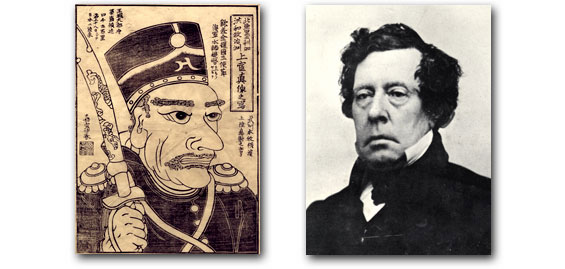 |
 Perry,
1854 Perry,
1854 |
Perry, 1852 |
 |
 Ryosenji
Treasure Museum Ryosenji
Treasure Museum |
Library of Congress |
Westerners
following Perry’s exploits from afar relied on photographs,
or far more commonly lithographs or woodcuts based on photographs,
to imagine what the commodore looked like. Around the time of the
Japan voyages, we encounter him in several renderings: sour in civilian
garb just before departing, for example, and posing in profile for
a photo used in casting a commemorative coin soon after he had returned.
|
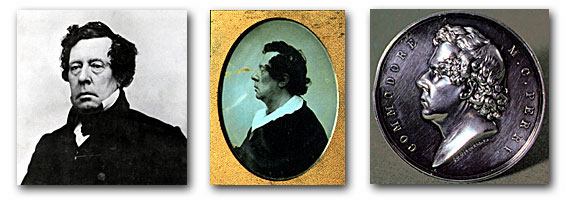 |
Daguerreotype
of Perry
1852
Library of Congress
 |
Silver
coin with Perry’s profile, 1855
and the daguerreotype on which it was based
US Naval Academy Museum

|
The
most famous portrait, taken by the great photographer Mathew Brady
after the completion of the Perry mission, portrays the commodore
standing in full uniform.
In popular illustrated periodicals, where photographs were reprocessed as lithographs and the like, his features became somewhat softened.
|
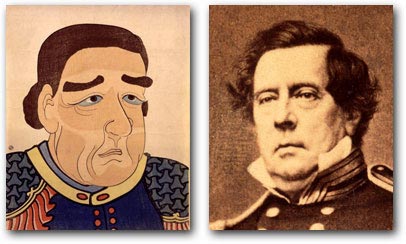 |
“Portrait of Perry,
a North American,”
woodblock print,
ca. 1854 (left)
Nagasaki Prefecture
Daguerreotype by
Mathew Brady (detail)
ca.1856
Library of Congress
 |

As
sometimes happened with especially popular woodblock prints, this
rendering of “Portrait of Perry, a North American” actually
circulated in several versions, with subtle variations in detail and
coloring. In some versions, the commodore’s hair is reddish—clearly
evoking the familiar depiction of the Dutch as “red hairs.”
And in some, the whites of Perry’s eyes are blue.
|
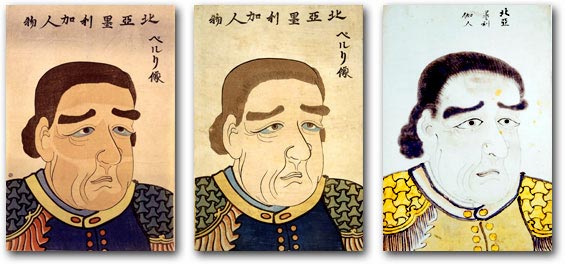 |
 Nagasaki
Prefecture Nagasaki
Prefecture
 |
Peabody Essex Museum
 |
  Ryosenji
Treasure Museum Ryosenji
Treasure Museum
 |
 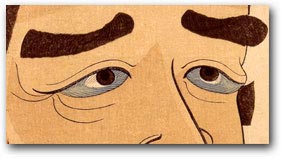 We
can offer both a simple and a more subtle explanation for these somewhat
startling eyeballs. In the popular parlance of feudal Japan, Westerners
were sometimes referred to as “blue-eyed barbarians,”
and it is possible that some artists were a bit confused concerning
where such blueness resided. That is the simple possibility. It was
also the case, however, that in colored woodblock prints in general—which
only emerged as a popular genre during the era of seclusion—ferocious
and threatening figures such as monsters and renegades were frequently
stigmatized by the same strange blue eyeball. Whatever the explanation,
popular renderings of Perry and his fellow “barbarians”
drew on conventions entrenched in the indigenous culture. We
can offer both a simple and a more subtle explanation for these somewhat
startling eyeballs. In the popular parlance of feudal Japan, Westerners
were sometimes referred to as “blue-eyed barbarians,”
and it is possible that some artists were a bit confused concerning
where such blueness resided. That is the simple possibility. It was
also the case, however, that in colored woodblock prints in general—which
only emerged as a popular genre during the era of seclusion—ferocious
and threatening figures such as monsters and renegades were frequently
stigmatized by the same strange blue eyeball. Whatever the explanation,
popular renderings of Perry and his fellow “barbarians”
drew on conventions entrenched in the indigenous culture.
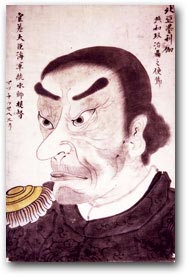
 Perry
as a long-nosed tengu Perry
as a long-nosed tengu
or goblin ca. 1854
 Ryosenji
Treasure Museum Ryosenji
Treasure Museum
|
Although
commercial artists immediately rowed out in small boats to draw pictures
of Perry’s fleet on the occasion of the first visit in July
1853, then and even thereafter few actually had the opportunity to
behold the commodore in person. This was due, in no little part, to
Perry’s decision to enhance his authority by making himself
as inaccessible as possible. Indeed, he remained so secluded prior
to the formal presentation of the president’s letter that some
Japanese, it is said, took to calling his cabin on the flagship “The
Abode of the High and Mighty Mysteriousness.”
Failing to see Perry personally left many artists with little but
their imaginations to rely on in depicting His High and Mighty Mysteriousness,
a situation that the majority of them serenely accepted and even
relished. And, in more than a few cases, they leave us with little
guesswork concerning where (beyond “red hairs” and “blue-eyed
barbarians”) their stereotypes were coming from. In one instance,
for example, we find the commodore presented as “Tengu Perry”—alluding
to the large, long-nosed goblin figures that folklore portrayed
as possessing uncanny powers.
 |
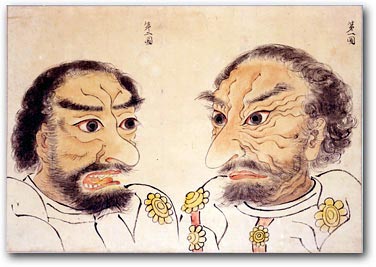 |

More common were prints and paintings that rendered Perry and his
fellow Americans conspicuously hirsute. In several such portraits,
we find him paired with Commander Henry A. Adams, his second-in-command.
Adams (left) and Perry
Ryosenji Treasure Museum |
Perry (left) and Adams,
from "The Pictorial Scroll
of the Arrival at Kurihama"
ca. 1854
Ryosenji Treasure Museum |
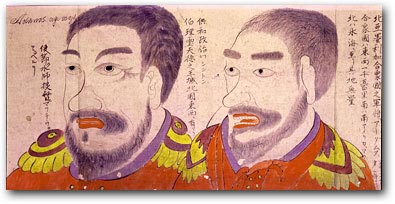 |
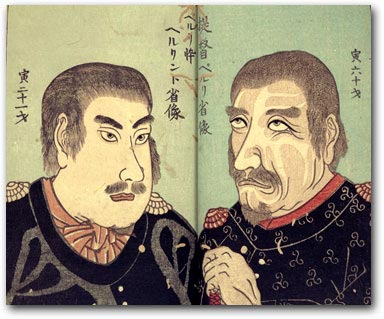 |

In another print, Perry is paired with his young son (named after
Perry’s famous brother Oliver), who accompanied him to Japan—here
sporting a trim mustache like his father, but lacking his father’s
goatee.
Perry and son,
woodblock print
1854
Ryosenji Treasure Museum

|
 A
painting of Oliver Perry alone, on the other hand, portrays
him not only clean-shaven, but looking remarkably like a delicate
and romantic Japanese youth. A
painting of Oliver Perry alone, on the other hand, portrays
him not only clean-shaven, but looking remarkably like a delicate
and romantic Japanese youth. |
Perry’s son Oliver, painting
ca. 1854
Ryosenji Treasure Museum
 |
 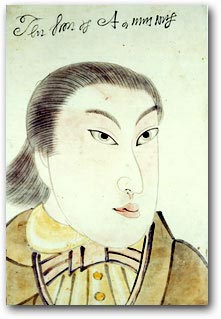 |
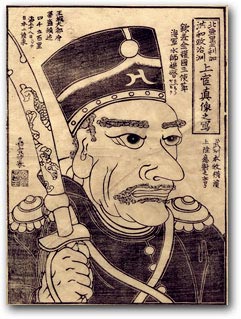 |
 
A well-known black-and-white kawaraban print of the commodore
hoisting a sheathed sword and wearing a strange brimless cap features
a thick mustache running parallel to bushy eyebrows.
Perry, kawaraban (broadsheet)
1854
Ryosenji Treasure Museum
 |
A
scroll painted in Shimoda in 1854, on the other hand, renders him
with both bushy hair and beard and trim hair and beard—as if
he had gone to the barber and returned while the artist was still
at work.
Why all this facial hair? The explanation lies primarily in the power
of imaginative language: ever since the distant 16th- and early-17th-century
encounter, another derisive sobriquet for Westerners was “hairy
barbarians” (keto or ketojin).
|
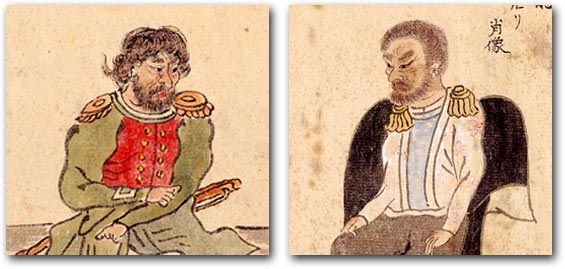 |
Two images of
Perry from the “Black Ship Scroll,” 1854
Honolulu Academy of Art |
On rare occasion, the commodore’s hairy visage was transparently
barbaric and even demonic—as if the American emissary were truly
one of the legendary demons or devils (oni and akuma)
that old folktales spoke about as dwelling across the seas. The most
vivid such renderings are to be found in some truly alarming close-ups
of both Perry and Adams that also appear in the Shimoda scroll.
|
 Portrait of Perry Portrait of Perry
from the “Black Ship Scroll”
Text: “True portrait of Perry, envoy of the Republic of North
America. His age is over sixty, complexion yellow, eyes slanted upwards,
nose impressive, lips red as if rouged. His hair is curled like rings
and mixed with gray. He wears three gold rings. His uniform is white
wool with raised crests woven in gold....”
Honolulu Academy of Art

|
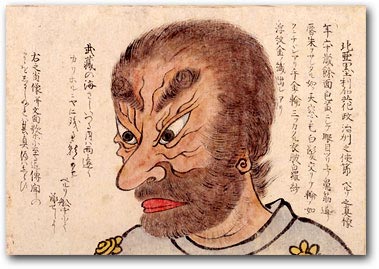 |
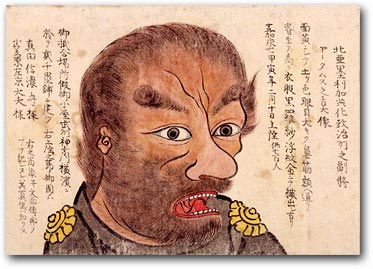 |
Portrait of Adams
from the “Black Ship Scroll”
Text: “True portrait of Adams, Second in Command from the Republic
of North America. His complexion is yellow with an earthy tone, eyes
large, nose high-bridged. He is very tall. His uniform is black wool
with raised crests woven with gold....”
Honolulu Academy of Art |

Even
this Shimoda scroll, however, suggests that appearances could be deceiving.
The text that surrounds its ferocious “True Portrait of Perry”
also includes the following poem, which the commodore was imagined
to have composed on board his flagship:
Distant moon that appears
over the Sea of Musashi,
your beams also shine on California.
Apparently, even barbarians might have Japanese-style poetic souls.
Indeed, when it came to painting and describing Adams’ 15-year-old
son, who accompanied the mission, the “Black Ship Scroll”
practically fell all over itself in portraying him as a paragon of
polyglot virtues—delicate, aesthetic, muscular, martial, and
a model of filial piety. |
Portrait of Adams’ son from the “Black Ship Scroll”
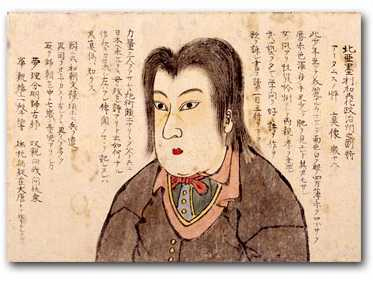
Text:
“This youth is extremely beautiful. His complexion is
white, around his eyes is pink, his mouth is small, and his
lips are red. His body, hands, and feet are slightly plump,
and his features are rather feminine. He is intelligent by nature,
dutiful to his parents, and has a taste for the martial arts.
He likes scholarship, composes and recites poems and songs,
and reads books three lines at a glance. His power exceeds three
men, and his shooting ability is exceptional....”
Honolulu Academy of Art

|
|
As we shall see again in other renderings of interactions with the
Perry mission, the commodore and his fellow Americans were also
drawn from direct observation on occasion, and depicted as being
simply people of a different race and culture. Their features were
sharper than their Japanese counterparts. Their clothing differed.
They comported themselves in occasionally peculiar ways. Clearly,
however, they shared a common humanity with the Japanese.
An informal watercolor of Perry and Adams painted by Hayashi Shikyo
in 1854, for example, conveys an impression of the two men as officers
rather weary with responsibility.
|
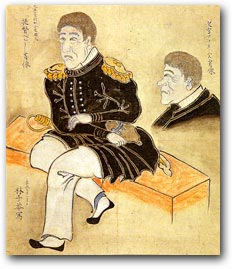
Perry
(left) and Adams,
by Hayashi Shikyo, 1854
Peabody Essex Museum

|
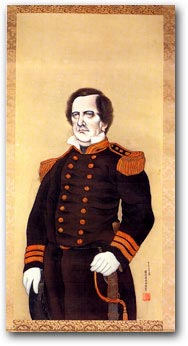
 |
Almost a half century later, Shimooka Renjo, who had actually participated
in one of the conferences with Perry, painted the commodore’s
portrait in watercolor and ink and mounted this as a traditional hanging
scroll (kakemono). Here was a Perry unlike those produced
in the tumult of the actual encounter: carefully executed, formal,
respectful, tinged with obvious Western painterly influence—and
still distinctively “Japanese.”
Kakemono (hanging scroll)
of Perry, by Shimooka Renjo
1901
Peabody Essex Museum
|
|
|

